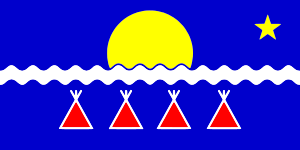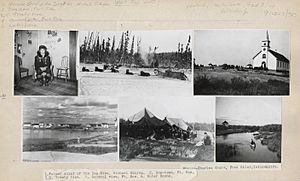Tłı̨chǫ facts for kids
 |
|

Tłįchǫ tipis c. 1900.
|
|
| Total population | |
|---|---|
| 1,935 | |
| Regions with significant populations | |
| Canada Northwest Territories |
|
| Languages | |
| Tłı̨chǫ, English | |
| Religion | |
| Christianity, Animism | |
| Related ethnic groups | |
| Yellowknives, Dënesųłiné, Sahtu |

The Tłı̨chǫ people, also called Tlicho or Dogrib, are a First Nations group in Canada. They are part of the larger Dene family. The Tłı̨chǫ live in the Northwest Territories and speak a language from the Athabaskan family.
Contents
What's in a Name?
The name Dogrib comes from an English version of their own name, Tłı̨chǫ Done. This means "Dog-Flank People." It refers to an old story about their ancestors coming from a magical dog-man.
Like other Dene groups, they often call themselves simply Done, which means "person" or "human." Their land is known as Ndé. On an old map from 1682, the name Dogrib was written as "Alimousp[i]goiak." This came from the Cree word Alimospikayak, also meaning "Dog-Flanks."
Tłı̨chǫ Communities
Today, the Tłı̨chǫ people live in six main communities. These places either have mostly Tłı̨chǫ residents or are Tłı̨chǫ settlements. They include:
- Behchoko (which used to be called Rae-Edzo)
- Whatì (also known as Lac la Martre)
- Gamèti (also known as Rae Lakes)
- Wekweeti (also known as Snare Lake)
- Dettah
- Ndilǫ (also called Rainbow Valley), which is a part of Yellowknife. The Tłı̨chǫ call Yellowknife Somba K'e, meaning "where the money is."

The Tłı̨chǫ language is called Tłı̨chǫ Yatıı̀. It is part of the Athabaskan languages family. The way they speak in Dettah and Ndilǫ is a special dialect. It developed because Tłı̨chǫ people and Yellowknives people married each other over time.
Important Agreements: Treaties
For many years, the Tłı̨chǫ people have worked to protect their lands and way of life through agreements called treaties.
Treaty No. 8 and the Yellowknife B Band
In June 1899, talks began for Treaty No. 8. This treaty covered a huge area of land in the Northwest Territory. It was an agreement between the Canadian Government and different Dene groups. The Dene agreed to share their land with non-Native people. In return, they would get help with health care and education, plus payments.
The Canadian Government and several Dene groups, including the Yellowknives and Tłı̨chǫ, signed this treaty in 1900. Chief Drygeese and headmen Benaiyah and Sek'eglinan signed for their people at Fort Resolution. After signing, the Tłı̨chǫ group that signed was called the "Yellowknife B Band." This treaty was the biggest land agreement the Canadian Government had ever made at that time.
Treaty No. 11 and the Dog Rib Rae Band
About 20 years after Treaty No. 8, oil was found in the Mackenzie River Valley. The Canadian Government wanted another treaty to allow miners and development in the area. The Native people debated this treaty a lot. They did not want to lose their right to hunt, fish, gather, and trap on their land. They also did not want to be forced to live on Indian reserves.
Many Dene felt that Treaty No. 8 had not been fully honored by the Canadian Government. Some were worried this new treaty would be the same. Still, Treaty No. 11 was signed by the Tłı̨chǫ trading chief Monfwi in the summer of 1921. The Tłı̨chǫ groups who signed this treaty became known as the "Dog Rib Rae Band." This group made up most of the Tłı̨chǫ population.
Both Treaty No. 8 and Treaty No. 11 cover some of the same land. This has caused disagreements between the two treaty groups, which are now two separate First Nations.
Not all members of the Dene and Tłı̨chǫ communities agreed with or signed these treaties. In 1992, the Tłı̨chǫ presented their own land claim to the Canadian government. Talks were supposed to start in 1994 between the Yellowknife B Band and the Dog Rib Rae Band. However, the Yellowknife B Band refused to join the talks. This made things difficult because both groups had overlapping land claims.
The main issue was self-governance, as both groups wanted to have a say in the agreement. This stopped the talks in 1994 while the Canadian government looked into the land boundaries and self-government issues. In 1997, a new plan allowed talks for a "joint land claims and self-government agreement with the Dogrib Treaty 11 Council."
In 1999, the agreement was ready for the Dogrib people to approve. They accepted it on January 7, 2000. A large number of the Dog Rib Rae Band (93%) voted, and over 84% voted for the agreement. After more community discussions and changes, the agreement was officially started in March 2003.
Tłı̨chǫ First Nations Today
Today, the Tłı̨chǫ people are organized into different First Nations groups.
Yellowknives Dene First Nation
The Yellowknife B Band (Treaty No. 8 Dogrib) became the Yellowknives Dene First Nation in 1991. This happened after talks for a territory-wide land claim agreement broke down. They are now working on their own land claim settlement as part of the Akaitcho Land Claim Process. This process is led by the Akaitcho Territory Government.
The Yellowknives Dene First Nation is also known as Weledeh Yellowknives Dene. It includes the Dettah Yellowknives Dene First Nation and Ndilǫ Yellowknives Dene First Nation. The Dettah group is named after Detah, which means 'Burnt Point' in Tłı̨chǫ. This refers to a traditional Dene fishing camp. The Ndilǫ group is pronounced DEE-loh. These groups speak the Dettah-Ndilǫ dialect of Tłı̨chǫ. Their ancestors include Tłı̨chǫ, Yellowknives, and Chipewyan people.
Tlicho Government
The Dog Rib Rae Band is now known as the Tlicho Government.
The Tlicho Agreement
The Tlicho Agreement became fully active on Thursday, August 4, 2005. This day marked "The first official day of the Tlicho Government and the Tlicho community governments." On August 25, 2003, they signed a land claims agreement with the Government of Canada. This agreement is also called Tłı̨chǫ.
This agreement gives the Tłı̨chǫ ownership of a large area of land. It covers about 39,000 square kilometers between Great Bear Lake and Great Slave Lake in the Northwest Territories. This territory includes the communities of Behchokǫ̀, Gamèti, Wekweeti, and Whatì. It also includes the Diavik Diamond Mine and Ekati Diamond Mine.
The four Tłı̨chǫ bands that existed before (Dog Rib Rae First Nation, Wha Ti First Nation, Gameti First Nation, and Dechi Laot'i First Nations) no longer exist as separate groups. Their main council, the Dogrib Treaty 11 Council, also ended. All of these groups are now part of the Tlicho Government.
The Tłı̨chǫ will have their own law-making bodies in the four communities. The chiefs of these bodies must be Tłı̨chǫ. However, anyone can run for a council position and vote. These law-making bodies will have the power to collect taxes and control hunting, fishing, and industrial development. They will also receive money from resource royalties, which used to go to the federal government.
The Tłı̨chǫ will also receive payments of $152 million over 15 years. They will also get about $3.5 million each year. The federal government will still control criminal law across Canada. The Northwest Territories government will still control services like health care and education.
This land-claims process took 20 years to finish. A similar process with the Inuit in the NWT led to the creation of the new territory of Nunavut. While Tłı̨chǫ will not be a separate territory, its new powers are very important. People compare it to the creation of Nunavut and the start of the NWT government in 1967.
Famous Tłı̨chǫ People
- Dahti Tsetso: An environmentalist and educator from the Dehcho First Nation.
- Richard Van Camp: A writer, known for his novel The Lesser Blessed.
- Bear Lake Chief (Kʼaàwidaà, “highest trader”): Also known as Francis Yambi, he was a very well-known Tłı̨chǫ trading chief from 1852 to 1913. He was a leader for Tłı̨chǫ groups trading at Old Fort Rae and Fort Norman.
- Chief Edzo: A great Tłı̨chǫ donekʼawi (trading chief). He took part in a famous peace treaty at Mesa Lake in 1825 (or 1829). This treaty ended a long period of fighting between the Yellowknives and Tłı̨chǫ.
- Dzemi (Ekawi Dzimi): A Tłı̨chǫ donekʼawi (trading chief) at Old Fort Rae and a leader of the Dechi Laotʼi (“Edge of the Woods People”).
- Ewainghan (Rabesca): A Tłı̨chǫ donekʼawi (trading chief) at Old Fort Rae and a leader of the Etʼaa gotʼin (“People Next to Another People”).
- Drygeese: A Tłı̨chǫ donekʼawi (trading chief) at Fort Resolution. He signed Treaty 8 in 1900 as a spokesperson for the Tłı̨chǫ and Yellowknives.
- Beniah: A Tłı̨chǫ donekʼawi (trading chief) at Fort Resolution.
- Little Crapeau: A Tłı̨chǫ donekʼawi (trading chief) at Fort Resolution.
- Chief Castor: A Tłı̨chǫ donekʼawi (trading chief) at Fort Resolution.
- Chief Monfwi (EwaroʼA “Small Mouth”): From 1866 to 1936, he was a Tłı̨chǫ donekʼawi (trading chief) and leader of the Dechi Laotʼi. He was chosen to represent all Tłı̨chǫ groups and signed Treaty 11 in 1921.
- James Wedzin: An artist from Behchoko, Northwest Territories, who is a member of this nation.
- The novel White Bird Black Bird by Val Wake tells a story about the Dogrib people's part in forming the NWT Indian Brotherhood. Much of the story takes place in what was then called Rae.
See also
 In Spanish: Tłįchǫ para niños
In Spanish: Tłįchǫ para niños
- Gahcho Kue Diamond Mine Project

